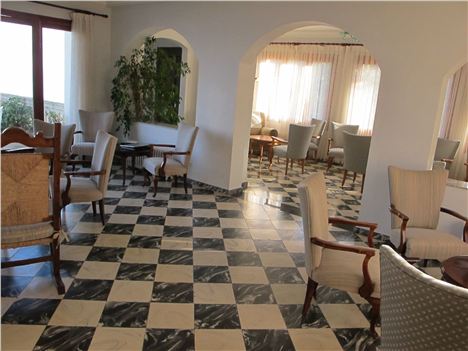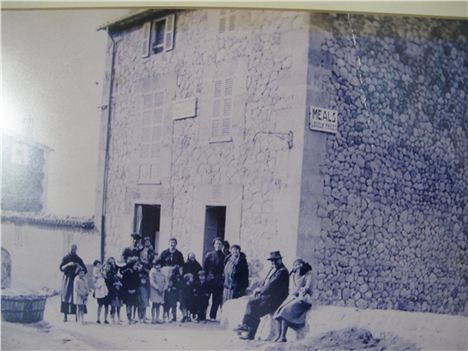ON the last occasion we walked in the Serra de Tramuntana we learned the meaning of mudslides. The first part of the walk from Deia to Valldemossa up through carob trees and holm oak woods was an uphill struggle, literally, but we were rewarded with spectacular views of Mallorca’s rugged north west coast. During our subsequent picnic the rains came and by the time we reached the legendary Archduke’s Bridleway they were torrential.
'Late noon was sweltering but the sheltered terrace gave us a perfect view of the comings and goings in the bay'
I’ve no reason to doubt Wikipedia: “The climate in the Tramuntana Range is significantly wetter than the rest of the island, recording as much as 59.3 inches of precipitation per year.” We appeared to get most of that in three hours plus a substantial portion of Tramuntana mud on on our breeches as we slid down to our destination.
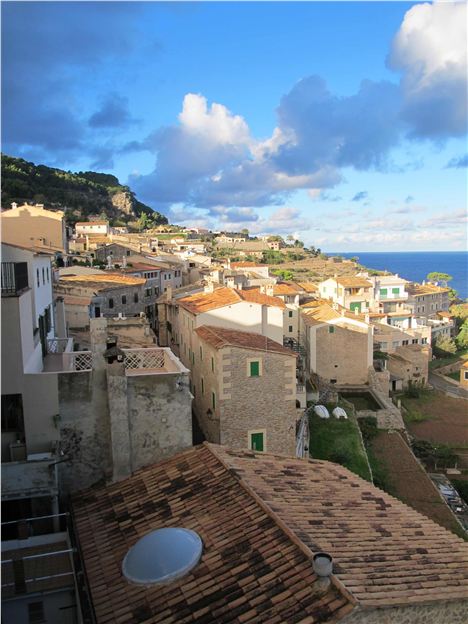 Banyulbafar tumbles down to the sea
Banyulbafar tumbles down to the sea
So it was with some trepidation I laced up my Brashers again on my favourite Mediterranean island. It was a comfort our base was the Hotel Mar i Vent – the first of two family-run lodgings we stayed in this time that define Balearic hospitality for me. It’s in Banyalbufar, a straggling village clinging to terraces above the coast. The second hotel, the Bon Sol, occupies a palatial prime site in built-up Illetas to the west of capital Palma but is equally unsnooty and warm. At both we had sea-facing terraces and much sunshine. Hooray!
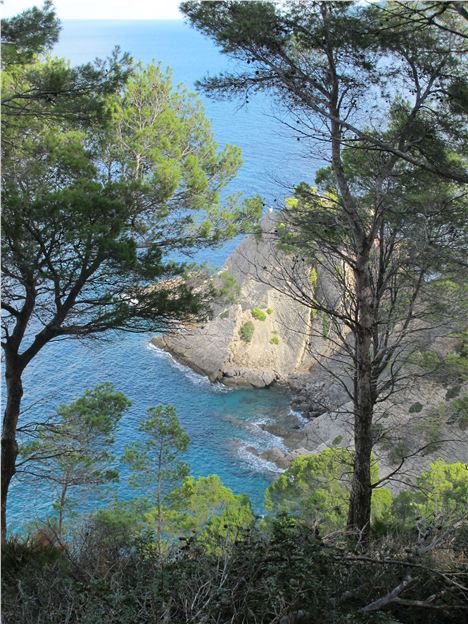 The walk to Port d'Es Canonge is breathtaking in its beauty
The walk to Port d'Es Canonge is breathtaking in its beauty
Admittedly the weather was undecided when we set out from Base Camp Banyalbufar for a gentle coastal walk (you have to build yourself up in stages). Swathes of cloud billowed over the mountains behind us. Our destination, an hour away to the north, was Port d’Es Canonge. You can reach this small rocky bay by car, but you’d be missing a lovely forested ramble involving coves, unusual rock formations and dashing waves.
 La Granja – country house open to the public with lots going on
La Granja – country house open to the public with lots going on
Canonge itself is just a fishing dock and a scattering of houses but the grilled sardines and mugs of Estrella beer were welcome at the Bar Can Mado.
Another fine walk, about twice as long is The Old Postman’s Route, which rises steeply up through ancient terraced plots to head over to inland Esporla and the patrician farm and museum open to the public called La Granja.
The huge mansion was originally a Cistercian Convent and only converted into a mansion 40 years ago. The various rooms, including a jail, are packed with historical furnishings and the grounds are lovely to explore. La Granja offers free tastings of Mallorcan specialities such as jams, cheese, fig cake and "sobrassada" (a sausage, alas, I’ve never acquired a taste for) as well as displays of old handicrafts, tools and machinery.
From Banyulbafar we took a further mountain walk to the south towards Estellencs – to a more modest private house called Planicia, set among olive groves. It was idyllic but, be warned: fenced private estates have closed off some paths beyond and it is frustrating trying get round.
There is little really to excite in sleepy Banyulbafar. That’s part of its charm. A couple of nice cafe bars, a sampling of the heady local white made from the malvasia grape, a calf-stretching jaunt down to the granite beach and you’re done.
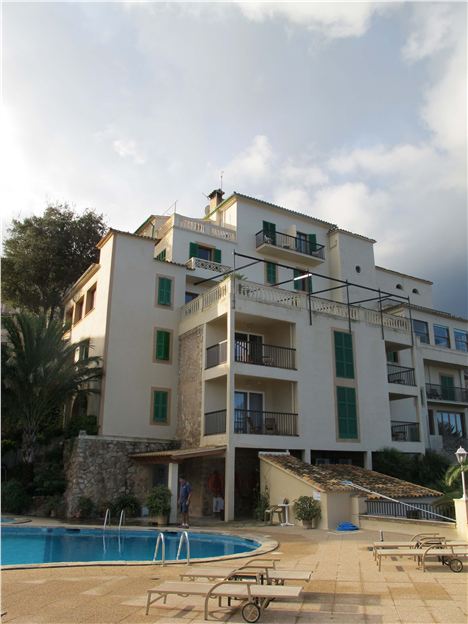 Mar i Vent and its pool; below, its traditional welcoming lounges
Mar i Vent and its pool; below, its traditional welcoming lounges
We were happy to chill out at the Mar i Vent. Our room had a large terrace with views sweeping down to the sea. Perfect for that cold beer moment on arrival. Yes the hotel is traditional, more homely than boutique, but it has a rare sense of belonging to its place.
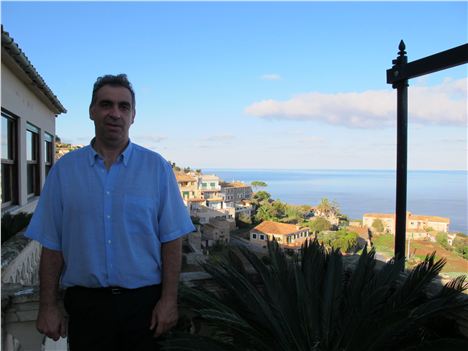 Francesco Vives and, below, a vintage image of the hotel from the Thirties
Francesco Vives and, below, a vintage image of the hotel from the Thirties
Proprietor Francesco Vives, a wry but engaging man, showed me pictures of his grandfather’s house in the Thirties before the family converted it into a hotel. It was only after the War and into the Fifties that Banyulbafar (Moorish for “founded by the sea”) was transformed from a remote agricultural hamlet into the low-key resort it is today.
The coast road it straddles is a switchback route of spectacular beauty. Apparently Bradley Wiggins and the GB cycling team tested their own calves more strenuously along here. Heading for Palma we eschewed the faster inland route and took the coast road down to Andratx, which hosts an immensely popular street market. The plan had been to push on to yachty Port d’Andratx for a fish lunch but the prospect of little Sant Elm lured us down a twisting back road.
It is a charming family beach resort previously off my radar. Some folk come for the boat trip over to Sa Dragonera island – a natural park with a silhouette like a dragon. Most just to chill – like us. At the Vistamar the last and best of the obligatory parade of restaurants along the harbour, we devoured paella and grilled bream with a glass of local Macia Batle white. Late noon was sweltering but the sheltered terrace gave us a perfect view of the comings and goings in the bay.
Palma, just a 30 minute drive away, is in such contrast – a major city with all the manic traffic you’d expect. I was glad we were staying out of town at Illetas, where parking is easier and the pace slower. Our hotel, the Bon Sol, occupies an alternative universe of beneficent hospitality and caring stewardship inside a disorienting maze of extensions.
 Bon Sol has its Gothic touches
Bon Sol has its Gothic touches
Inside the Moorish-style shell of the original building the elaborate tapestries and suits of armour ought to spell kitsch, but they don’t. And the more you explore the various levels reached by lifts and tunnels, culminating in a private cove, the more treats you find.
 Bon Sol's private cove at dusk
Bon Sol's private cove at dusk
We hadn’t time to check out the spa, but fitted in yoga and table tennis and enjoyed the well-oiled formality of the bar and restaurant service. That’s when we weren’t sipping cava on our balcony as the lights came on across the Bay of Palma.
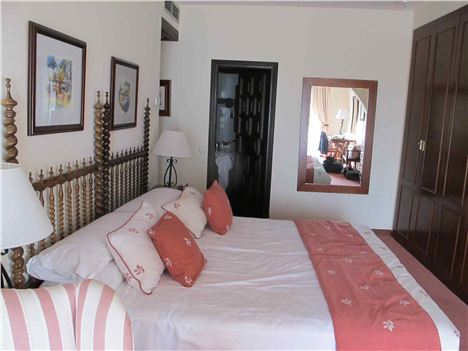 Our Bon Sol room; below, the view from our terrace and the dining room
Our Bon Sol room; below, the view from our terrace and the dining room
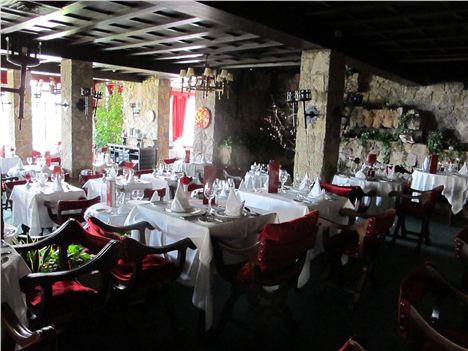 For 60 years the Bon Sol has been in the hands of the Xamena family. Current owners twinkly Martin Xamena and his Croydon-born wife Lorraine are blooding their son Alejandro in the Bon Sol tradition. This involves attending to every need of the mature clientele who come back time and time again. The devotion to detail is staggering. In high season, the hotel caters equally well for families, I am told.
For 60 years the Bon Sol has been in the hands of the Xamena family. Current owners twinkly Martin Xamena and his Croydon-born wife Lorraine are blooding their son Alejandro in the Bon Sol tradition. This involves attending to every need of the mature clientele who come back time and time again. The devotion to detail is staggering. In high season, the hotel caters equally well for families, I am told.
It’s hard to tear yourself away into Palma, but make the effort. The true must-see there is La Seu, the vast Gothic cathedral which dominates the city from land and sea, but the Moorish warren of the old town is addictive.
 Le Seu – Palma's imposing Cathedral
Le Seu – Palma's imposing Cathedral
The tapas bar to visit is blue-tiled Sa Boveda in the Calle Boteria. It's always packed, so hang around with a beer and pa amb boli (tomato, garlic, olive oil on bread) till a table becomes free. They have an overflow joint around the corner near the harbour, but it is not as characterful.
There is character, too, at Abaco bar in the neighbouring Calle San Joan. It's like something out of a Busby Berkeley musical with lots of gilt, caged birds and intimidatingly lavish flower and fruit arrangements. Be warned – also intimidating is the price of staple cocktails and champagne.
For culture, the best bet is Es Baluard, a modernistic contemporary art museum set spectacularly in the walls of the medieval military fortress and featuring Picasso, Klee and lots of Miro. The sculpture-laden terrace is also a good place for affordable cocktail sipping. But If you are really into Miro then look no further than Illetas itself, where there’s a fascinating museum devoted to the work of Mallorca’s adopted son – the Fundacio Pilay y Joan Miro.
The great Catalan artist’s mother was Mallorcan; he married a young Mallorcan woman called Pilar Juncosa in 1929; in 1940 Nazi air raids on France made him seek shelter on the island where he eventually settled permanently in 1954, setting up a cluster of studios. The Fundacio, best reached from tacky Cala Major, is based around a modernistic gallery and San Boter, a 17th century country house purchased by the artist in 1959.
 The Cuevas del Drac; below, the Martel Lake
The Cuevas del Drac; below, the Martel Lake
 One of nature’s great works of art lies 65km east of Palma at Porto Cristo and we made it our final excursion of the trip. The Cuevas del Drach are a sequence of four flooded caves with more stupendous rock formations than you could shake a stalactite at. They culminate in a rock amphitheatre housing the awesome Martel Lake, which is 1150m in length and 30m in width. The obligatory group trips down below culminate in a son et lumiere show involving costumed classical musicians performing while gliding by on boats. Quite magical.
One of nature’s great works of art lies 65km east of Palma at Porto Cristo and we made it our final excursion of the trip. The Cuevas del Drach are a sequence of four flooded caves with more stupendous rock formations than you could shake a stalactite at. They culminate in a rock amphitheatre housing the awesome Martel Lake, which is 1150m in length and 30m in width. The obligatory group trips down below culminate in a son et lumiere show involving costumed classical musicians performing while gliding by on boats. Quite magical.
 Misty mountains, Deia; below,view from the other side of the ridge in sunlight
Misty mountains, Deia; below,view from the other side of the ridge in sunlight
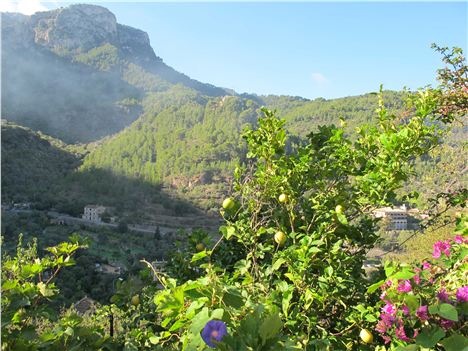 As was our return to flower-decked Deia, set breathtakingly on its mountain ridge. We went in homage to Robert Graves, buried under a simple headstone in the hilltop churchyard there. Partly because the anniversary of Great War is under two years way –his Goodbye To All That is one of the best accounts of the frontline – partly because it was exactly 40 years since my wife and I, as students, had dined with the great man.
As was our return to flower-decked Deia, set breathtakingly on its mountain ridge. We went in homage to Robert Graves, buried under a simple headstone in the hilltop churchyard there. Partly because the anniversary of Great War is under two years way –his Goodbye To All That is one of the best accounts of the frontline – partly because it was exactly 40 years since my wife and I, as students, had dined with the great man.
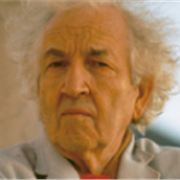
It was in an Oxford steakhouse. The tall toff with a shock of white hair, legendary survivor of the Great War, pagan poet, author of I Claudius, barely graced student us with his attention as he dominated a dinner table of aficionados.
Robert Graves (pictured) was 75 then and not too far into the future would lapse into dementia. But that night his voice rang out with startling clarity at a poetry reading – like some god descended from Olympus. He lived in Olympian Deia most of his life, initiating a bohemian legacy that remains despite the fact that most struggling artists couldn’t afford to live here these days. Ca n'Alluny, the house he moved into in 1929, is now a museum to his memory, but like so many of these literary shrines is slightly antiseptic. Immortal I Claudius aside, Graves is quite out-of-fashion and visiting seems just one of those tourist obligations.
Better to defy the lowering clouds and stride up in the Tramuntana massif. There’s poetry in them thar World Heritage Status hills... and not a little mud if you time it wrong.
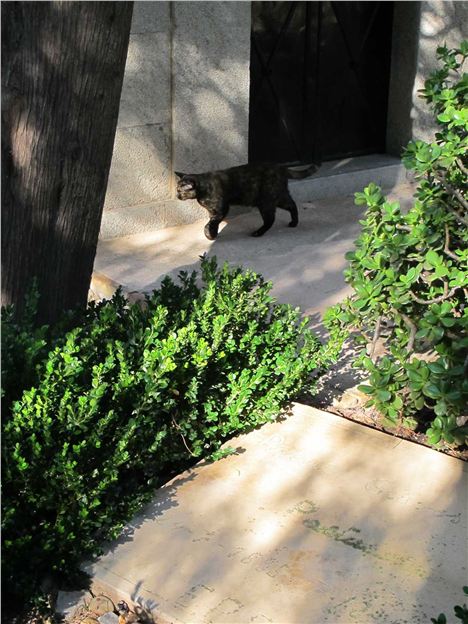 Cemetery cat watches over Robert Graves's simple tombstone
Cemetery cat watches over Robert Graves's simple tombstone
Fact file
Getting there:
Monarch airlines offers twice daily flights to Palma from Manchester. Book at www.monarch.co.uk or ring 08700 40 63 00.
Staying there:
Hotel Mar i Vent, Carrer Major 49, Banyalbufar (+34 971 618201, www.hotelmarivent.com). Double room rates from €98 with breakfast.
Hotel Bonsol, Paseo de Illetas, E07181 Illetas, Mallorca (+34 971 402 111, www.ila-chateau.com/bonsol. Double twin rates from low season €99 to high season €140 per person on half board basis. Special 60th anniversary packages throughout 2013.
To see:
La Granja, private farm and museum, near Esporles www.lagranja.net/en
Fundacio Pilay y Joan Miro a Mallorca, C. De Saridakis, 29 07015 Palma http://miro.palmademallorca.es
Cuevas del Drach (or Coves del Drac/Caves of the Dragon), 07680 Porto Cristo. http://www.cuevasdeldrach.com
Eating and drinking in Palma:
Taberna de La Boveda, Paseo Sagrera, 3, Palma
Abaco Calle de San Juan, 1, 07012, Palma,
Manchester Airport parking:
Neil Sowerby left his car park in T2 Long Stay. Here are all the options:
VIP Valet – drop and collect your car right next to the terminal and get fast tracked through security. Your car is parked on site.
Meet and Greet – drop your car off with staff next to the terminal and collect on your return. Your car is parked on site.
Multi-storey car park at T1, 2 and 3 – ultra-convenient multi-storey car parking right next to the terminal. Park and walk under cover to reach the terminal.
Long stay car park at T1, 2 and 3 – ground surface car park offering free, regular 24 hour bus transfers direct to the terminal.
Shuttle Park – secure parking at great rates for cost-conscious travellers. Free, regular 24 hour bus transfers direct to the terminal.
JetParks – low-cost parking option run by Manchester Airport, fully manned 24/7, parking from £2.99 per day. Visit this link www.manchesterairport.co.uk/car-parking/









